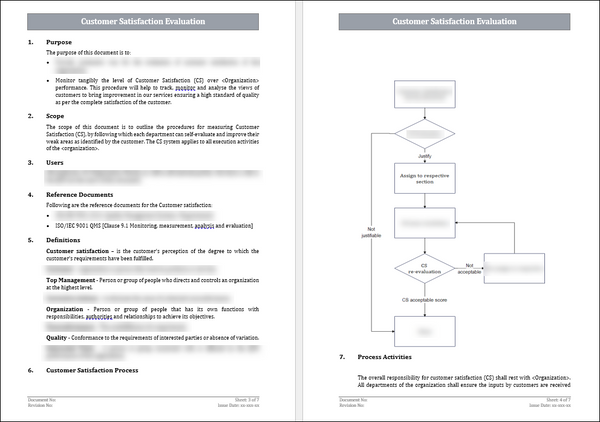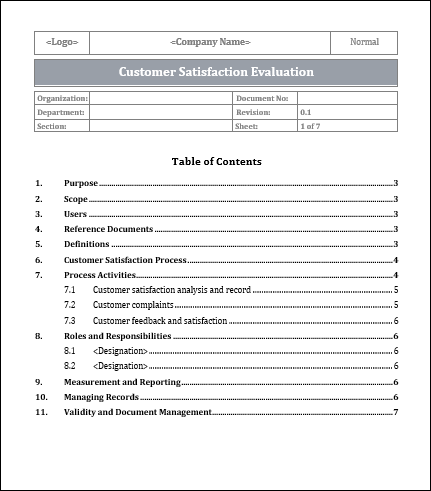ISO 9001 Customer Satisfaction Procedure Template
Customer Satisfaction Procedure Template provides a systematic approach for measuring and enhancing customer satisfaction within an organization. This procedure outlines the steps required to gather customer feedback, analyze the results, and implement actions to improve customer satisfaction levels. By following this template, organizations can establish a consistent process for assessing customer satisfaction, which ultimately leads to better customer relationships and increased customer loyalty.
Understanding The Importance of Customer Satisfaction in ISO 9001
- Meeting customer expectations: ISO 9001 is an international standard that emphasizes customer satisfaction as the ultimate goal of any organization. By focusing on customer satisfaction, organizations can ensure that their products or services meet the expectations and requirements of their customers.
- Improving customer loyalty: Satisfied customers are more likely to be loyal to a brand or organization. They are more likely to repeat their purchase and recommend the product or service to others. This can lead to increased customer retention and a positive reputation for the organization.
- Enhancing brand reputation: Customer satisfaction plays a crucial role in shaping the reputation of an organization. A satisfied customer is more likely to speak positively about the brand, while an unsatisfied customer may spread negative word-of-mouth. By prioritizing customer satisfaction, organizations can build a strong and positive brand reputation.
- Increasing competitiveness: In today's competitive marketplace, customer satisfaction can be a key differentiator. Organizations that consistently deliver high levels of customer satisfaction are more likely to attract and retain customers, giving them a competitive edge over their rivals.
- Driving continuous improvement: ISO 9001 encourages organizations to establish a process approach and continuously improve their quality management system. By monitoring and measuring customer satisfaction, organizations can identify areas for improvement and take corrective actions to enhance customer experience and meet or exceed customer expectations.
- Reducing customer complaints and returns: Customer satisfaction is closely linked to the number of complaints and returns an organization receives. By focusing on customer satisfaction, organizations can identify and address potential issues before they escalate, reducing the number of complaints and returns and saving costs associated with rectifying these issues.
- Employee engagement and motivation: Satisfied customers have a positive impact on employees as well. When customers are happy with the products or services, employees feel a sense of accomplishment and pride in their work. This, in turn, increases employee motivation and engagement, leading to higher productivity and improved customer service.
- Long-term business success: Ultimately, customer satisfaction is crucial for the long-term success of an organization. Happy and satisfied customers are more likely to become repeat customers and advocates for the brand. By consistently meeting customer expectations, organizations can secure a loyal customer base and achieve sustainable growth and profitability.
Key Components of a ISO 9001 Customer Satisfaction Procedure Template
- Description of Change: This component provides a detailed explanation of any changes made to the ISO 9001 customer satisfaction procedure template. It ensures that all stakeholders are informed and aware of the modifications.
- Controls for Records Protection: This component outlines the measures and processes in place to protect customer satisfaction records. It ensures the confidentiality and security of sensitive customer feedback and data.
- Retention Time: This component specifies the duration for which customer satisfaction records should be retained. It ensures compliance with legal and regulatory requirements and facilitates future reference or audit purposes.
- Customer Satisfaction Survey received: This component refers to the receipt of customer satisfaction surveys. It highlights the importance of collecting feedback from customers to assess their satisfaction levels and identify areas for improvement.
- CS Evaluation: This component focuses on the evaluation of customer satisfaction data and feedback received. It involves analyzing the survey results, identifying trends, and measuring overall customer satisfaction levels.
- CS issue resolution: This component describes the process for addressing and resolving any customer satisfaction issues or concerns raised. It emphasizes the importance of timely and effective solutions to enhance customer experience.
- CS re-evaluation: This component emphasizes the need for periodic re-evaluation of customer satisfaction levels. It ensures continuous improvement and enables organizations to track progress against previous evaluations.
- Re-assign respective: This component involves re-assigning responsibilities or tasks to individuals or departments based on the evaluation and resolution of customer satisfaction issues. It ensures accountability and effective management of customer satisfaction.
- CS acceptable score: This component establishes a benchmark or acceptable score for customer satisfaction. It provides a measure against which organizations can evaluate their performance and strive for continuous improvement.

The Benefits of Implementing a Customer Satisfaction Procedure
Implementing a customer satisfaction procedure as part of an ISO 9001 certification can bring several benefits to a company. Here is a pointwise explanation of these benefits:
- Improved customer loyalty: A customer satisfaction procedure helps a company identify and address customer concerns promptly. By satisfying customer needs and expectations, businesses can enhance customer loyalty, leading to repeat business and positive word-of-mouth referrals.
- Enhanced reputation: ISO 9001 certification is internationally recognized and respected. By implementing a customer satisfaction procedure, a company demonstrates its commitment to providing quality products and services, which can strengthen its reputation among customers and stakeholders.
- Increased customer retention: Satisfied customers are more likely to continue doing business with a company. By measuring and improving customer satisfaction, companies can reduce customer churn and retain a higher percentage of their customer base.
- Competitive advantage: A customer satisfaction procedure can help a company differentiate itself from competitors. Businesses that consistently meet or exceed customer expectations are more likely to attract new customers and outperform competitors in the marketplace.
- Continuous improvement: The ISO 9001 standard emphasizes the importance of continuous improvement. By implementing a customer satisfaction procedure, companies are encouraged to actively seek feedback from customers and use it to identify areas for improvement, leading to enhanced processes and products.
- Cost reduction: A customer satisfaction procedure can help companies identify and address any issues that may be causing customer dissatisfaction. By resolving these issues, companies can reduce the costs associated with customer complaints, returns, and warranty claims.
- Employee engagement: A customer satisfaction procedure involves employees at various levels in the organization, promoting their engagement and involvement in satisfying customer needs. Engaged employees are more likely to provide better customer service, resulting in improved customer satisfaction.
- Data-driven decision making: A customer satisfaction procedure involves collecting and analyzing data on customer satisfaction. This data can help companies make informed decisions based on customer feedback, preferences, and trends, leading to improved products, services, and processes.
Conclusion
The ISO 9001 Customer Satisfaction Procedure template is a document that provides a structured approach for organizations to measure and monitor customer satisfaction. It outlines the necessary steps and activities to gather feedback from customers, assess their satisfaction levels, and take corrective actions if needed. By implementing this template, organizations can improve customer relationships, enhance their products or services, and ultimately achieve higher levels of customer satisfaction.


